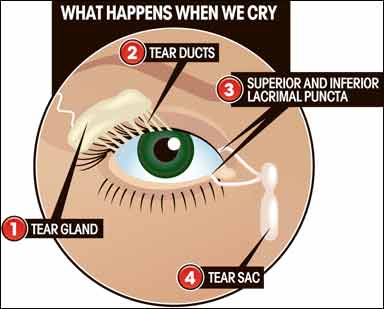WHY ARE MY EYES DRY FROM CONTACT LENSES?
As a Licensed Optician I love interacting one-on-one with clients. One of the most common complaints that I hear about is dry eyes from contact lens wear.
I've got a few handy tips to help with this problem, but in order to get there, I need to first tell you about the composition of tears and the role tears play in eye health.

TEAR DUCTS
Tears are made up of 3 layers: lipid, aqueous, and mucin. These 3 layers each have a part to play in preventing dry eye. The lipid (fatty) layer prevents evaporation. The aqueous or lacrimal layer makes up most of the volume of the tear film. This layer carries nutrients, washes away unwanted or dangerous bacteria or foreign objects. The mucin layer is the glue holding the tears to the cornea. If there is a problem with any of these layers which prevents optimal functioning then you end up with dry eyes.
MOVEMENT
When I fit contacts, one of the key points to a good fit is good tear flow. I also need to make sure that there is good lens movement, this will ensure that the lens won’t inhibit tear flow over time. Without these it is unlikely that my client will be comfortable. It’s also really important to be aware of client’s history as they can have a big impact on comfort as it relates to dry eyes. Some key information includes: age, medications, environmental factors (a/c or heating systems, dry climates, smoke or dust), hormone fluctuations, blinking problems and diseases can all be problematic. Another way discomfort can arise is when contacts aren’t cared for properly.
DISCOMFORT
Deposits and over wear can lead to discomfort which people interpret as dry eyes. Our eyes don’t have specific receptors to help us differentiate what is causing discomfort so what may feel like dry eyes can actually be caused by discomfort. There are a few variations in the way contacts are manufactured. High water lenses sound like they would be comfortable but one issue that may arise is osmotic shift. This is when the water content of the lens is absorbed by the eye. This will result in the lens sticking to eye.
TIPS FOR FIXING DRY EYES
Solutions depend on the issues that are causing the discomfort but some tips might include:
- Using a wetting agent in the form of a drop to extend wear time can work for some, though I caution doing this without talking to your eye health practitioner as it can sometimes mask another problem and lead to more damage. A more frequent replacement schedule can help if the symptoms are a result of lens deposits.
- Switching to a lens with lower water content or a rigid gas permeable lens if you are prone to dry eyes may help increase comfort.
- Try a silicone hydrogel lens with a quality wetting agent, this can help those who are experiencing discomfort from lack of oxygen. Some of my top lenses for comfort are the silicone hydrogel lenses including (by order of my favorites)
- Acuvue Oasys – available in toric for astigmatism and multifocal varieties and is made up of 38% water.
- Biofinity by Cooper Vision which has a 48% water content. Only a toric and spherical option here.
- Air Optix Aqua and Air Optix Night & Day by CIBA Vision is also great. Air Optix come in a multi-focal and an astigmatic option, however, the Night and Day don’t have multi-focal or toric lenses
- Purevision and Purevision 2 by Bausch and Lomb are not my favorites for dry eyes but I know many fitters who do really well with the Bausch and Lomb lenses. They do have a great multi-focal lens for presbyopes and their toric lenses are easy fits for astigmatic patients.
If you are having symptoms of dry eyes or discomfort when wearing your contact lenses make an appointment to have you optician or eye care professional to get checked and possibly re-fit with a lens better suited to your needs.